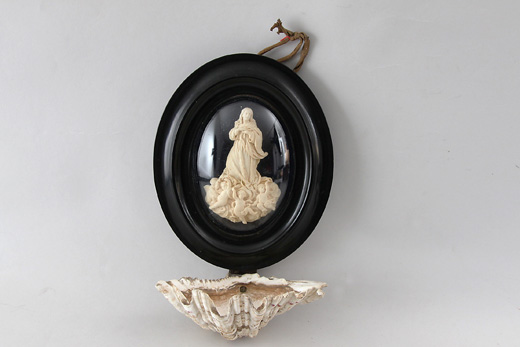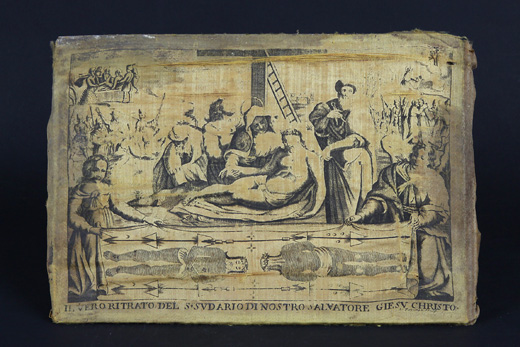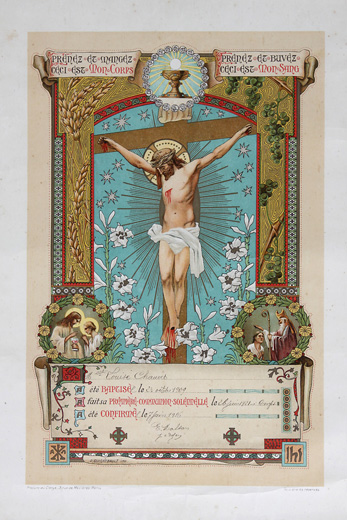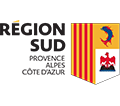Religions and beliefs in the collections of the Museum to the Moyen Verdon
The Catholic religion is omnipresent in the Moyen Verdon region which is less secular and dechristianized in the 20th century than the Basse Provence region. The confraternities of penitents still existed during the 19th century. Confronted to a hostile environment, the people of the mountain looked for the help of the saints and the protection of God. That is why many chapels, oratories and crosses were built during that time. Most of the objects decorating the inside of the houses were religious: fonts, crucifixes and rosaries to hang above the bed, holy pictures, and wax statuettes of the saints or those of Jesus.
Religious life set the annual calendar. Blessings and consecrations occupied a key position between religion and magic. Blessed objects were supposed to have the magical power of protection. That is why the blessed bread of Saint Antoine of Castellane was consumed, given to animals and stored. The Candlemas candle was used to put “crosses of smoke” on the doors and windows of a house to protect it from every evil. A boxwood sprig blessed on Palm Friday was kept in the bedroom and nailed to the stable’s door.
Pilgrimages had a special importance and value as opportunities for people to meet each other and celebrate. In the Verdon region, the three predominant Marian shrines were the Notre-Dâme de Beauvoir of Moustier Saint Marie, the Notre-Dâme du Roc of Castellane and the Notre-Dâme de la Fleur of Thorame.

N° d’inventaire : 2011.8.16
Domaine musée : croyances-coutumes
Dénomination : Bénitier d’applique
Date de création : 1ère moitié du 20e siècle
Matières et techniques : bois peint ; coquillage ; galalithe
Dimensions : l. 16 ; L. 24 ; E. 10 ; Pds. 542
Description : Récipient à eau bénite en coquillage surmonté d'une plaque composée d'un cadre en bois peint en noir. Sous verre une représentation en bas-relief de l'assomption. L'ensemble peut être fixé au mur au moyen d'un lacet.
Utilisation : Objet lié au culte
Description de l’acquisition : Objet provenant de Sisteron entré en collection en 2011

N° d’inventaire : 2012.0.117
Domaine musée : croyances-coutumes
Dénomination : Gravure imprimée d’image pieuse
Matières et techniques : soie ; pin
Dimensions : l. 19, L. 27.5
Description : Gravure imprimée sur soie collée sur une planchette de pin représentant au premier plan le saint suaire tenu par deux anges ; au deuxième plan une descente de croix, au troisième plan à droite le baiser de Judas et Jésus au Mont des Oliviers, et à gauche le calvaire et la mise au tombeau.
Inscription : « Il vero ritrato del Sudario di nostro Salvatore Giesu Christo »
Utilisation : Souvenir – objet de culte
Description de l’acquisition : Objet provenant du Plan de la Palud de Castellane entré en collection en 1993.

N° d’inventaire : 2012.14.4
Domaine musée : croyances-coutumes
Dénomination : certificat religieux
Matières et techniques : papier
Dimensions : H. 44, l. 31
Description : Certificat religieux confirmant le baptême, la première communion solennelle et la confirmation de Louise Chauvet, accompagné d'une image pieuse représentant le Christ sur la croix.
Inscription :
"prenez et mangez ceci est mon corps " ;
" prenez et buvez ceci est mon sang " ;
" Mlle Louise Chauvet / A été baptisée le 23 octobre 1909 / A fait sa Première communion solennelle le 26 juin 1921 à Comps / A été confirmée le 7 juin 1926 »
Utilisation : Certificat religieux reçu pour confirmation de ses actes de foi.
Description de l’acquisition : Objet provenant de Comps en Artuby et donné à l’association en 2012










